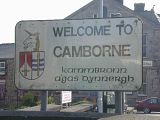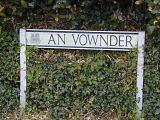Now, I should have known it was too good to last. In April this year, all of that structure was swept away and replaced with the one size fits all Cornwall Council. I haven`t followed the transition at all closely, but I can imagine that the proposal was met with some resistance which possibly grew stronger the farther west you went. And they would have been right to have their reservations, for it is there that Cornishness is felt at its most compelling and beguillng. On a visit to Praa Sands last week, deep into what used to be Kerrier District, I noticed what looked like fairly new street name plates sprouting up, all in English and Cornish, almost as if in their dying throes, Kerrier District had been determined to leave its mark in the way it felt most telling against their submergence into the monolithic Cornwall Council. One road didn`t even bother to tell you that `An Vownder`was `The Garden.`........
Search This Blog
Tuesday, September 15, 2009
SIZE ISN`T EVERYTHING
In my eclectic `library,` I have an interesting volume, which is `Philips Handy Administrative Atlas of England and Wales.` It was published in 1928 and contains maps and detailed descriptions of each of the Parliamentary and Local Government areas at that time. "Fascinating!" I hear you cry. But in truth, it is a remarkable insight into how England and Wales were `organised` 80 years ago and it shows the difference between how things were then and how they are now.
One of the best examples of that change is Cornwall. Now, I did promise not to bore you with tales from last week`s holiday, but one thing in particular came to my attention whilst I was down there last week. Philips Handy Administrative Atlas shows that, all those years ago, Cornwall had its County Council but also no less than 12 Municipal Boroughs including Penzance, Falmouth and Truro of course, but also smaller ones such as Lostwithiel with a population of just 1,307.
Then there were 16 Urban Districts, the largest being Camborne along with much smaller ones such as Ludgvan (pop. 2,052.) Then came 16 Rural Districts, which included the Scilly Isles and, bizarrely, "Holsworthy (part of)" most of which is in Devon anyway. After that came countless Parish Councils and so it`s safe to say that the whole of Cornwall was more than adequately covered by this startling structure of local government. (As an aside, at the other end of the country, right slap bang in the middle of Newcastle, there was actually a Newcastle-upon-Tyne Rural District comprising an area of one acre and a population of five, so Cornwall was by no means an exceptional case.)
Since 1974, Cornwall has been divided into six identifiable districts - North Cornwall, Caradon, Restormel, Carrick, Kerrier and Penwith. The further west you went, the more `Cornish` things became and so, for example, the far west districts of Kerrier and Penwith introduced the sensible policy of having place names and street name plates in both English and Cornish. Lelant is also shown as Lannanta, St Ives as Porthia and so on, all of which helps to establish in the minds of residents and visitors alike the fact that you are in a country apart - one with a singular heritage and with its own customs, history and language.
Now the new Cornwall Council might just turn out to be more efficient, more `value-for-money for council taxpayers,` more administratively convenient from all that 1928 and 1974 stuff, but I hope it encourages and promotes the Cornish identity and builds on the examples set in places like Kerrier and Penwith. I don`t know why I should worry as I`m not Cornish and I only go there to savour its magic and even when I do I feel as if I am intruding. But it is that mystery, that spirit of place, that keeps me going back for more. I`ll be keeping tabs on Cornwall Council, for it is true that size isn`t everything and in all the diversity that is Cornwall, I doubt its one size will suit everyone.
Subscribe to:
Post Comments (Atom)



No comments:
Post a Comment